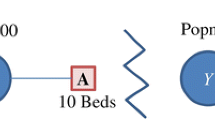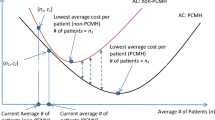Abstract
Our research is motivated by the proliferation of primary care models in Ontario, Canada. Currently, primary care is mainly provided by facilities belonging to six models of care. These models are remunerated by various schemes—a mixture of fee-for-service, capitation and salary. In addition, they provide different levels of care and several are better adjusted than others to treat complex health needs. The proposed mixed integer programming model allows the regulator to test the outcomes of locating different types of primary care facilities on the overall cost, accessibility and appropriateness of provided care. The network design is fitted to the heterogeneity of the population residing in a defined geographical area, directly using an index (deprivation index) that was found to correlate with increased health needs and barriers to care. The model capabilities are illustrated on the geographical area of Kingston, Ontario.







Similar content being viewed by others
References
Auditor General of Ontario (2011). Annual report. Section 3.06. Available at http://www.auditor.on.ca/en/reports_2011_en.htm, accessed 13 July 2014.
Berman O, Krass D and Menezes MBC (2007). Facility reliability issues in network p-median problems: Strategic centralization and co-location effects. Operations Research 55 (2): 332–350.
Biro S, Sehdev A, Belanger P and Moore K (2012). Understanding health inequities and access to primary health care in southeastern Ontario. Report prepared for the Belleville Quinte West Community Health Centre. Available at http://www.kflaphi.ca/wp-content/uploads/HealthInequities_FullReport.pdf, accessed 13 July 2014.
Blomqvist Å, Kralj B and Kantarevic J (2013). Accountability and access to medical care: Lessons from the use of capitation payments in Ontario. C.D. Howe Institute Ebrief 168. Available at http://www.cdhowe.org/pdf/e-brief_168.pdf, accessed 13 July 2014.
Brandeau ML and Chiu SS (1989). An overview of representative problems in location research. Management Science 35 (6): 645–674.
Cho CJ (1998). An equity-efficiency trade-off model for the optimum location of medical care facilities. Socio-economic Planning Sciences 32 (2): 99–112.
Dahrouge S et al (2009). The comparison of models of primary care in Ontario (COMP-PC) study: Methodology of a multifaceted cross-sectional practice-based study. Open Medicine 3 (3): 149–164.
Daskin MS and Dean LK (2004). Location of health care facilities. In: Brandeau ML, Sainfort F and Pierskalla WP (eds). Operations Research and Health Care: A Handbook of Methods and Applications. Kluwer: New York, NY, pp 4376.
Erkut E, Ingolfsson A and Erdoğan G (2008). Ambulance location for maximum survival. Naval Research Logistics 55 (1): 42–58.
Glazier RH, Zagorski BM and Rayner J (2012). Comparison of primary care models in Ontario by demographics, case mix and emergency department use, 2008/09 to 2009/10. ICES Investigative Report. Toronto: Institute for Clinical Evaluative Sciences. Available at http://www.ices.on.ca/Publications/Atlases-and-Reports/2012/Comparison-of-Primary-Care-Models, accessed 13 July 2014.
Green LV, Savin S and Lu Y (2013). Primary care physician shortages could be eliminated through use of teams, nonphysicians, and electronic communication. Health Affairs 32 (1): 11–19.
Griffin MP, Scherrer CR and Swann JL (2008). Optimization of community health center locations and service offerings with statistical need estimation. IIE Transactions 40 (9): 880–892.
Günes ED, Yaman H, Çekyay B and Verter V (2014). Matching patient and physician preferences in designing a primary care facility network. Journal of the Operational Research Society 65 (4): 483–496.
Hefford M, Crampton P and Foley J (2005). Reducing health disparities through primary care reform: The New Zealand experiment. Health Policy 72 (1): 9–23.
Hodgson MJ (1988). An hierarchical location-allocation model for primary health care delivery in a developing area. Social Science and Medicine 26 (1): 153–161.
Hogg W et al (2009). Health promotion activity in primary care: Performance of models and associated factors. Open Medicine 3 (3): 165–173.
Hutchison B and Glazier R (2013). Ontario’s primary care reforms have transformed the local care landscape, but a plan is needed for ongoing improvement. Health Affairs 32 (4): 695–703.
Hutchison B, Levesque JF, Strumpf E and Coyle N (2011). Primary health care in Canada: Systems in motion. The Milbank Quarterly 89 (2): 256–288.
Kalcsics J, Nickel S and Schröder M (2005). Towards a unified territory design approach—Applications, algorithms and GIS integration. Sociedad de Estadística e Investigación Operativa TOC 13 (1): 1–56.
Khan MM, Ali D, Ferdousy Z and Al-Mamun A (2001). A cost-minimization approach to planning the geographical distribution of health facilities. Health Policy and Planning 16 (3): 264–272.
Lamarche PA, Beaulieu MD, Pineault R, Contandriopoulos AP, Denis JL and Haggerty J (2003). Choices for change: The path for restructuring primary healthcare services in Canada. Ottawa: Canadian Health Services Research Foundation. Available at http://www.cfhi-fcass.ca/Migrated/PDF/ResearchReports/CommissionedResearch/choices_for_change_e.pdf, accessed 13 July 2014.
McLafferty S and Broe D (1990). Patient outcomes and regional planning of coronary care services: A location-allocation approach. Social Science and Medicine 30 (3): 297–304.
Mestre AM, Oliveira MD and Barbosa-Póvoa A (2012). Organizing hospitals into networks: A hierarchical and multiservice model to define location, supply and referrals in planned hospital systems. OR Spectrum 34 (2): 319–348.
Milliken O, Devlin RA, Barham V, Hogg W and Dahrouge S (2011). Comparative efficiency assessment of primary care service delivery models using data envelopment analysis. Canadian Public Policy 37 (1): 85–109.
Mitropoulos R, Mitropoulos I, Giannikos I and Sissouras A (2006). A biobjective model for the locational planning of hospitals and health centers. Health Care Management Science 9 (2): 171–179.
Muldoon L, Rowan MS, Geneau R, Hogg W and Coulson D (2006). Models of primary care service delivery in Ontario: Why such diversity? Healthcare Management Forum / Canadian College of Health Service Executives 19 (4): 18–23.
Pampalon R, Hamel D, Gamache P and Raymond G (2009). A deprivation index for health planning in Canada. Chronic Diseases in Canada 29 (4): 178–191.
Pomey MP, Martin E and Forest PG (2009). Quebec’s family medicine groups: Innovation and compromise in the reform of front-line care. Canadian Political Science Review 3 (4): 31–46.
Reid R, Bogdanovic B, Roos NP, Black C, MacWilliam L and Menec V (2001). Do some physician groups see sicker patients than others? Implications for primary care policy in Manitoba. Winnipeg, MB: Manitoba Centre for Health Policy and Evaluation. Available at http://mchp-appserv.cpe.umanitoba.ca/reference/acg2001.pdf, accessed 13 July 2014.
Russell G, Dahrouge S, Tuna M, Hogg W, Geneau R and Gebremichael G (2010). Getting it all done. Organizational factors linked with comprehensive primary care. Family Practice 27 (5): 535–541.
Shah CP (2003). Public Health and Preventive Medicine in Canada. 5th edn University of Toronto Press: Toronto, Canada.
Smith HK, Harper PR and Potts CN (2013). Bicriteria efficiency/equity hierarchical location models for public service application. Journal of the Operational Research Society 64 (4): 500–512.
Starfield B (2012). Primary care: An increasingly important contributor to effectiveness, equity, and efficiency of health services. SESPAS Report 2012. Gaceta Sanitaria S.E.S.P.A.S. 26(1): 20–26.
Starfield B and Simpson L (1993). Primary care as part of US health services reform. The Journal of the American Medical Association 269 (24): 3136–3139.
Starfield B, Shi L and Macinko J (2005). Contribution of primary care to health systems and health. Milbank Quarterly 83 (3): 457–502.
Verter V and Lapierre SD (2002). Location of preventive health care facilities. Annals of Operations Research 110 (1–4): 123–132.
Wilton P and Smith RD (1998). Primary care reform: A three country comparison of ‘budget holding’. Health Policy 44 (2): 149–166.
Wodchis WP, Bushmeneva K, Nikitovic M and McKillop I (2011). Guidelines on person-level costing using administrative databases in Ontario. Toronto: Health System Performance Research Network. Available at http://www.hsprn.ca/uploads/files/Guidelines_on_PersonLevel_Costing_May_2013.pdf, accessed 13 July 2014.
Zhang Y, Berman O, Marcotte P and Verter V (2010). A bilevel model for preventive healthcare facility network design with congestion. IIE Transactions 42 (12): 865–880.
Zhang Y, Berman O and Verter V (2012). The impact of client choice on preventive healthcare facility network design. OR Spectrum 34 (2): 349–370.
Acknowledgements
The authors would like to thank Dr Kieran Moore and Dr Paul Belanger from KFL&A Public Health for the help with defining the scope of the problem and data collection, provided while preparing this article. In addition, the authors would like to thank the computing facility at HPCVL for providing the CPLEX capabilities for the full-size instance. Two anonymous reviewers greatly improved this article by providing valuable inputs.
Author information
Authors and Affiliations
Corresponding author
Appendix
Appendix
Presented here is an example of assignment percentages from DAs with DI=5 to the different models of care. This is part of the solution for the full size example with parameters W d =0.1, W NAS =1 and W c =0.03.

Rights and permissions
About this article
Cite this article
Graber-Naidich, A., Carter, M. & Verter, V. Primary care network development: the regulator’s perspective. J Oper Res Soc 66, 1519–1532 (2015). https://doi.org/10.1057/jors.2014.119
Received:
Accepted:
Published:
Issue Date:
DOI: https://doi.org/10.1057/jors.2014.119




